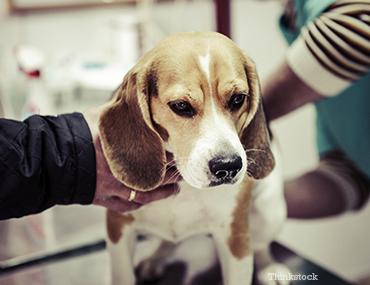
Disseminated intravascular coagulation, commonly called DIC, is a common complication seen in emergency room (ER) or intensive care unit (ICU) pets. Patients don’t develop DIC as a primary cause. It’s not a disease that occurs by itself; rather, DIC is a complication that is seen as a result of secondary underlying causes in the body. With DIC, the body is unable to clot normally.
Normally, the body’s ability to clot is complex and involves multiple stages: tissue factor, platelets, clotting factors, fibrin, and components that break down fibrin. With DIC, abnormal clotting typically results in either abnormally fast clotting (called hypercoagulablity) – where the body is predisposed to throwing microscopic blood clots, or abnormally delayed clotting (called hypocoagulablity) – where the body loses the ability to clot and uncontrollable, life-threatening bleeding may be seen.
There are several primary causes that can predispose the body to this blood clotting disorder:
- Cancer (e.g., hemangiosarcoma, etc.)
- Heat stroke
- Pancreatitis
- Sepsis (abnormal bacteria entering the blood stream secondary to a severe infection)
- Septic peritonitis (secondary to abnormal bacteria in the abdomen, typically due to the intestines rupturing)
- Heartworm disease (which is why it’s so important to keep your dog on year-round heartworm medication)
- Gastric dilatation-volvulus (GDV)
- Immune-mediated diseases such as immune-mediated hemolytic anemia (IMHA) or immune-mediated thrombocytopenia (ITP)
- Trauma
- Snake bites
- Infections
- Severe hemorrhage
Clinical signs of DIC include the following:
- Bleeding from the nose
- Blood in the eye
- Small pin-point bruising of the skin (called petechiae)
- Larger bruises (called ecchymosis)
- Increased heart rate
- Difficulty breathing
- Increased respiratory rate
- Abnormal bleeding from any orifice
Keep in mind that other clinical signs may be seen due to the primary disease. For more information on each specific disease (e.g., gastric-dilatation volvulus) please see the appropriate handout or blog on Pet Health Network.
The diagnosis of DIC is based on a clotting test (typically called a “coagulation panel.”) There are several different types of clotting tests available to veterinarians, some being more complete and extensive than others. When testing for DIC, typically, three of these abnormal blood tests need to be run before the blood clotting disorder can be “defined” as DIC. Classically, it’s a low platelet count and prolonged prothrombin time (PT) and activated partial thromboplastin time (aPTT).
Types of blood clotting tests include the following:
- A platelet count: This test often comes with a complete blood count (CBC – see below). Normal platelet count ranges from approximately 200,000-300,000/µl. With DIC, the platelet count is always decreased below the normal range.
- A coagulation panel: This test often includes the prothrombin time (PT), activated partial thromboplastin time (aPTT), fibrinogen, and fibrin split products (FSP/fibrin) degradation products (FDP). With DIC, the PT and PTT are typically prolonged (i.e., elevated), while the fibrinogen levels are low. The FSP and FDP levels are typically elevated.
- D-dimers: D-dimers test for the presence of breakdown products of crosslinked fibrin. This is not a typical test that veterinarians have readily available.
Some other key diagnostic blood clotting disorder tests that need to be performed typically include the following:
- A CBC which looks at the red blood cell count, white blood cell count, and platelet count
- A biochemistry panel to assess kidney and liver function, protein, and electrolytes
- Chest and abdominal x-rays to look for presence of cancer or underlying disease
- Abdominal ultrasound to look at the architecture inside of the organs
- A urinalysis to rule out underlying infection, kidney function, etc.
Unfortunately, there’s no cure or specific treatment for DIC, aside from fixing the underlying primary problem (e.g., surgery for a GDV). If severe clotting problems are noted, a fresh frozen plasma transfusion can be given to help provide clotting factors to a patient. Likewise, aggressive intravenous (IV) fluids may be necessary to help hydrate the patient. Symptomatic supportive care typically includes hospitalization at a 24/7 facility for oxygen therapy, IV fluid therapy, blood pressure, and electrocardiogram monitoring. Frequent monitoring of the patient along with clotting tests, red blood cell count, and platelet count rechecks should be performed.
With aggressive care, the primary disease may be treatable, as long as the secondary side effects of DIC don’t result in life-threatening clotting abnormalities. Remember that with any disease or medical problem the sooner it is diagnosed, the sooner it can be treated.
If you have any questions or concerns, you should always visit or call your veterinarian – they are your best resource to ensure the health and well-being of your pets.
